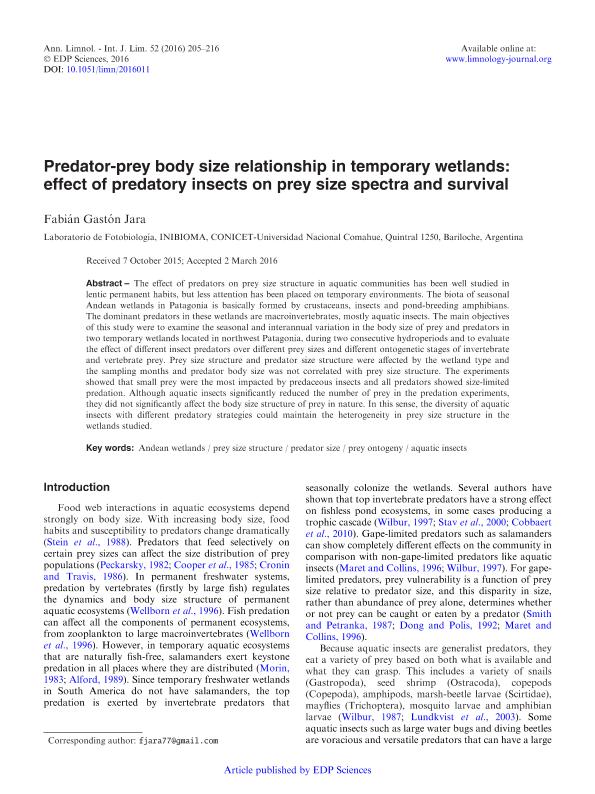Mostrar el registro sencillo del ítem
dc.contributor.author
Jara, Fabian Gaston

dc.date.available
2018-11-21T16:39:31Z
dc.date.issued
2016-03
dc.identifier.citation
Jara, Fabian Gaston; Predator-prey body size relationship in temporary wetlands: Effect of predatory insects on prey size spectra and survival; EDP Sciences; Annales de Limnologie-International Journal of Limnology; 52; 10; 3-2016; 205-216
dc.identifier.issn
0003-4088
dc.identifier.uri
http://hdl.handle.net/11336/64842
dc.description.abstract
The effect of predators on prey size structure in aquatic communities has been well studied in lentic permanent habits, but less attention has been placed on temporary environments. The biota of seasonal Andean wetlands in Patagonia is basically formed by crustaceans, insects and pond-breeding amphibians. The dominant predators in these wetlands are macroinvertebrates, mostly aquatic insects. The main objectives of this study were to examine the seasonal and interannual variation in the body size of prey and predators in two temporary wetlands located in northwest Patagonia, during two consecutive hydroperiods and to evaluate the effect of different insect predators over different prey sizes and different ontogenetic stages of invertebrate and vertebrate prey. Prey size structure and predator size structure were affected by the wetland type and the sampling months and predator body size was not correlated with prey size structure. The experiments showed that small prey were the most impacted by predaceous insects and all predators showed size-limited predation. Although aquatic insects significantly reduced the number of prey in the predation experiments, they did not significantly affect the body size structure of prey in nature. In this sense, the diversity of aquatic insects with different predatory strategies could maintain the heterogeneity in prey size structure in the wetlands studied.
dc.format
application/pdf
dc.language.iso
eng
dc.publisher
EDP Sciences

dc.rights
info:eu-repo/semantics/openAccess
dc.rights.uri
https://creativecommons.org/licenses/by-nc-sa/2.5/ar/
dc.subject
Andean Wetlands
dc.subject
Aquatic Insects
dc.subject
Predator Size
dc.subject
Prey Ontogeny
dc.subject
Prey Size Structure
dc.subject.classification
Otras Ciencias Biológicas

dc.subject.classification
Ciencias Biológicas

dc.subject.classification
CIENCIAS NATURALES Y EXACTAS

dc.title
Predator-prey body size relationship in temporary wetlands: Effect of predatory insects on prey size spectra and survival
dc.type
info:eu-repo/semantics/article
dc.type
info:ar-repo/semantics/artículo
dc.type
info:eu-repo/semantics/publishedVersion
dc.date.updated
2018-11-13T20:34:46Z
dc.identifier.eissn
2100-000X
dc.journal.volume
52
dc.journal.number
10
dc.journal.pagination
205-216
dc.journal.pais
Francia

dc.journal.ciudad
Paris
dc.description.fil
Fil: Jara, Fabian Gaston. Consejo Nacional de Investigaciones Científicas y Técnicas. Centro Científico Tecnológico Conicet - Patagonia Norte. Instituto de Investigaciones en Biodiversidad y Medioambiente. Universidad Nacional del Comahue. Centro Regional Universidad Bariloche. Instituto de Investigaciones en Biodiversidad y Medioambiente; Argentina
dc.journal.title
Annales de Limnologie-International Journal of Limnology

dc.relation.alternativeid
info:eu-repo/semantics/altIdentifier/doi/https://dx.doi.org/10.1051/limn/2016011
dc.relation.alternativeid
info:eu-repo/semantics/altIdentifier/url/https://www.limnology-journal.org/articles/limn/abs/2016/01/limn150067/limn150067.html
Archivos asociados
